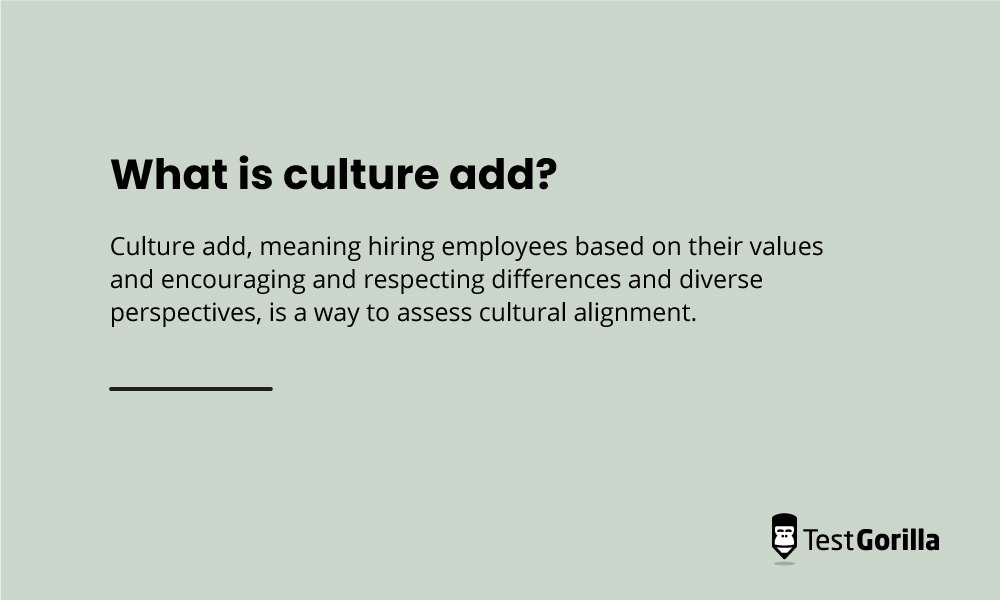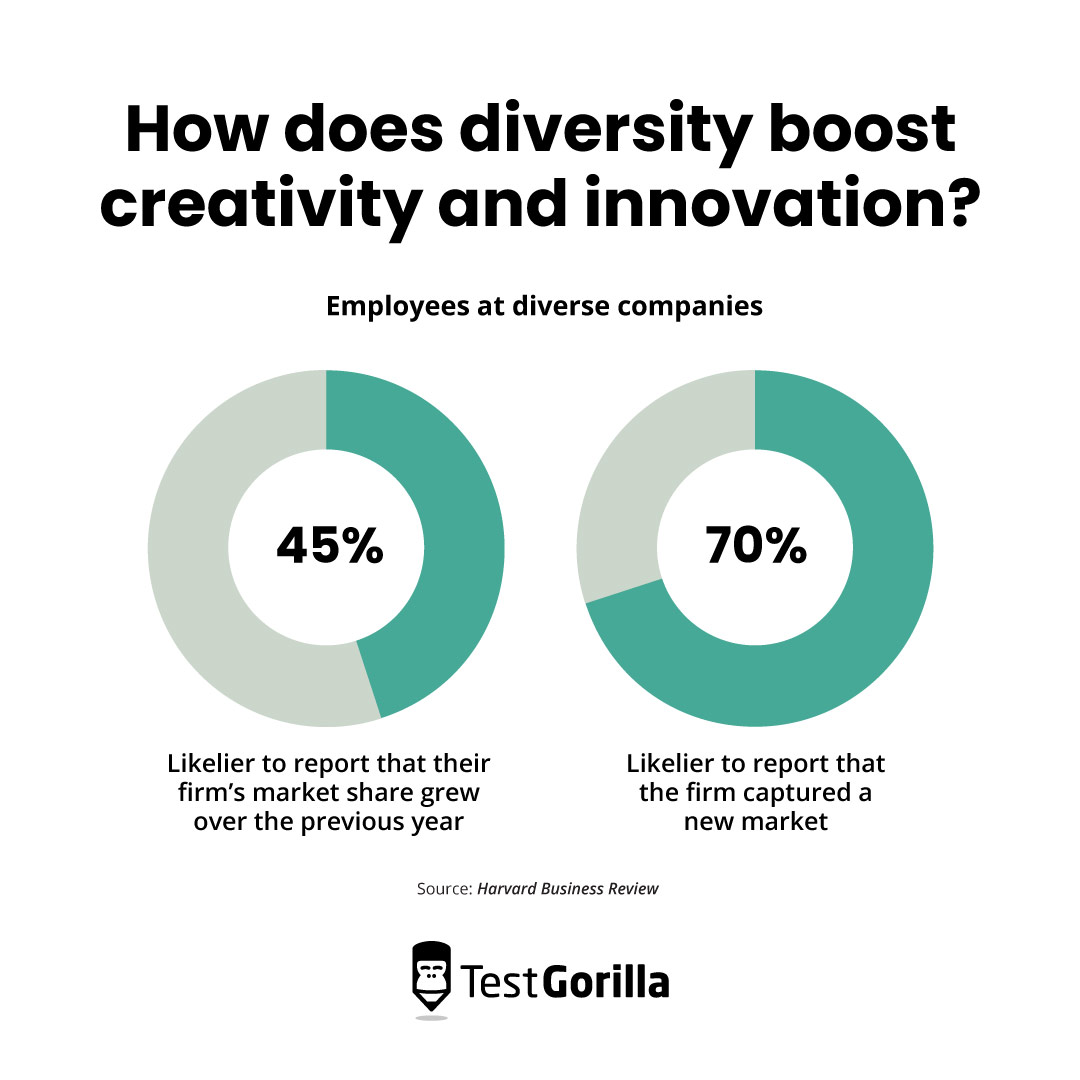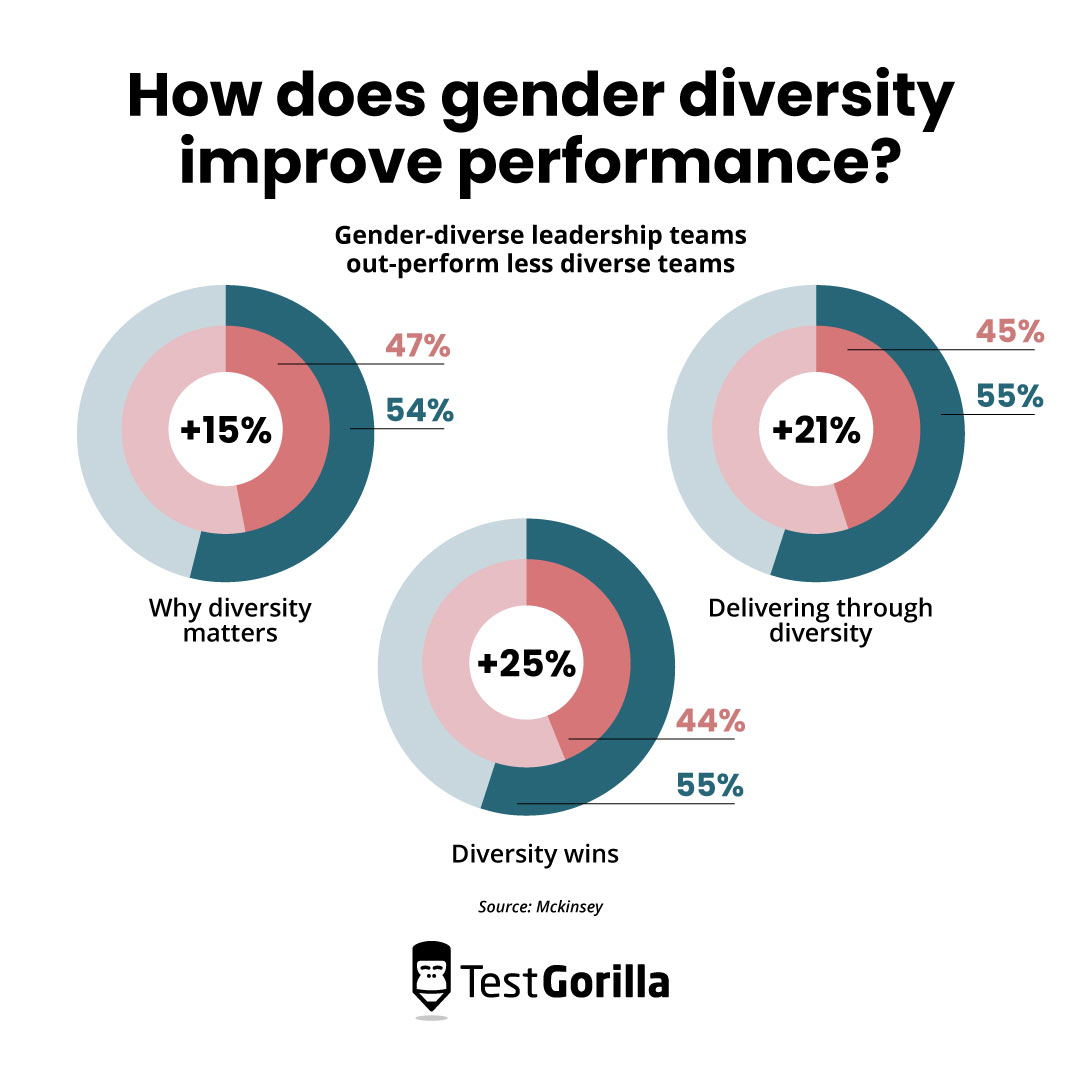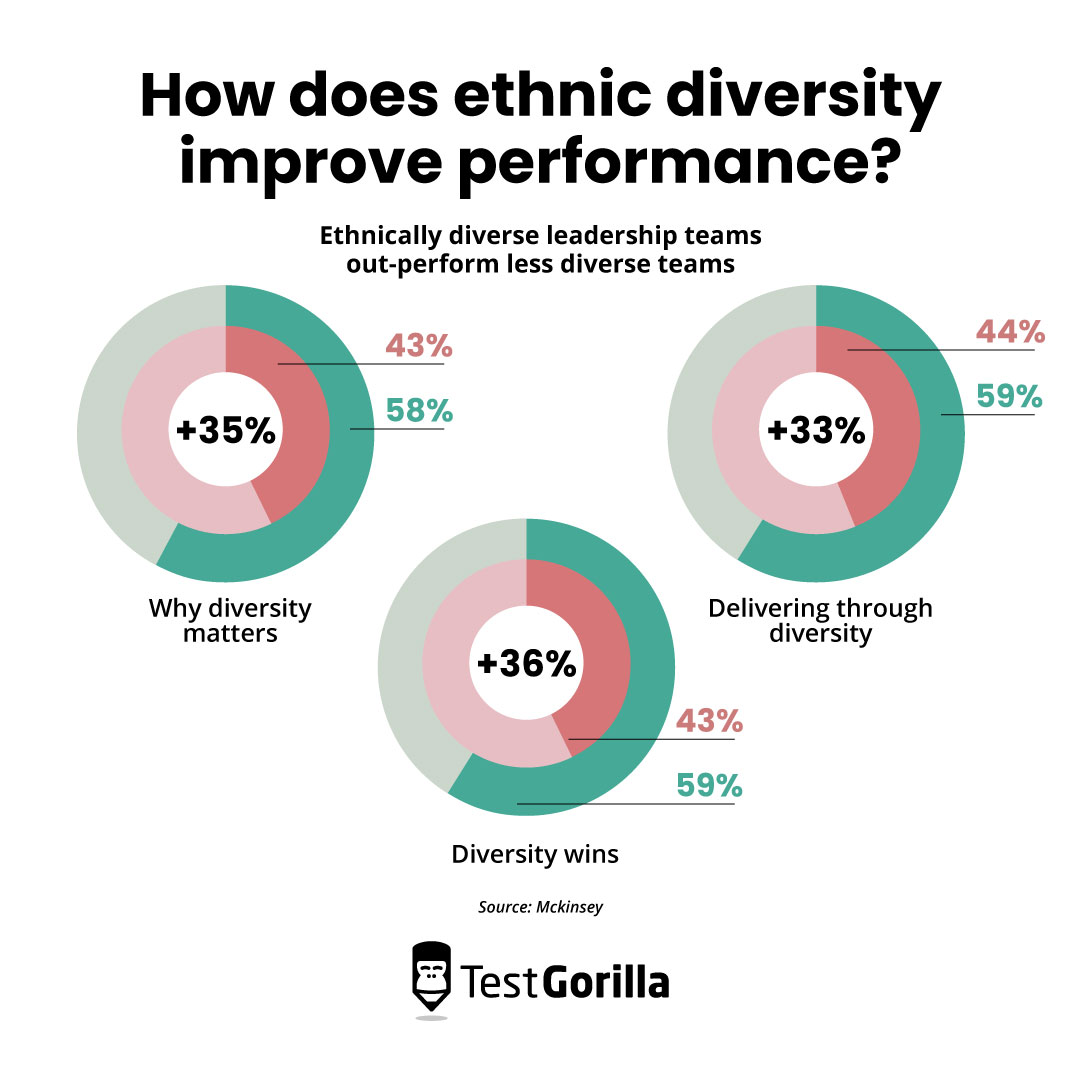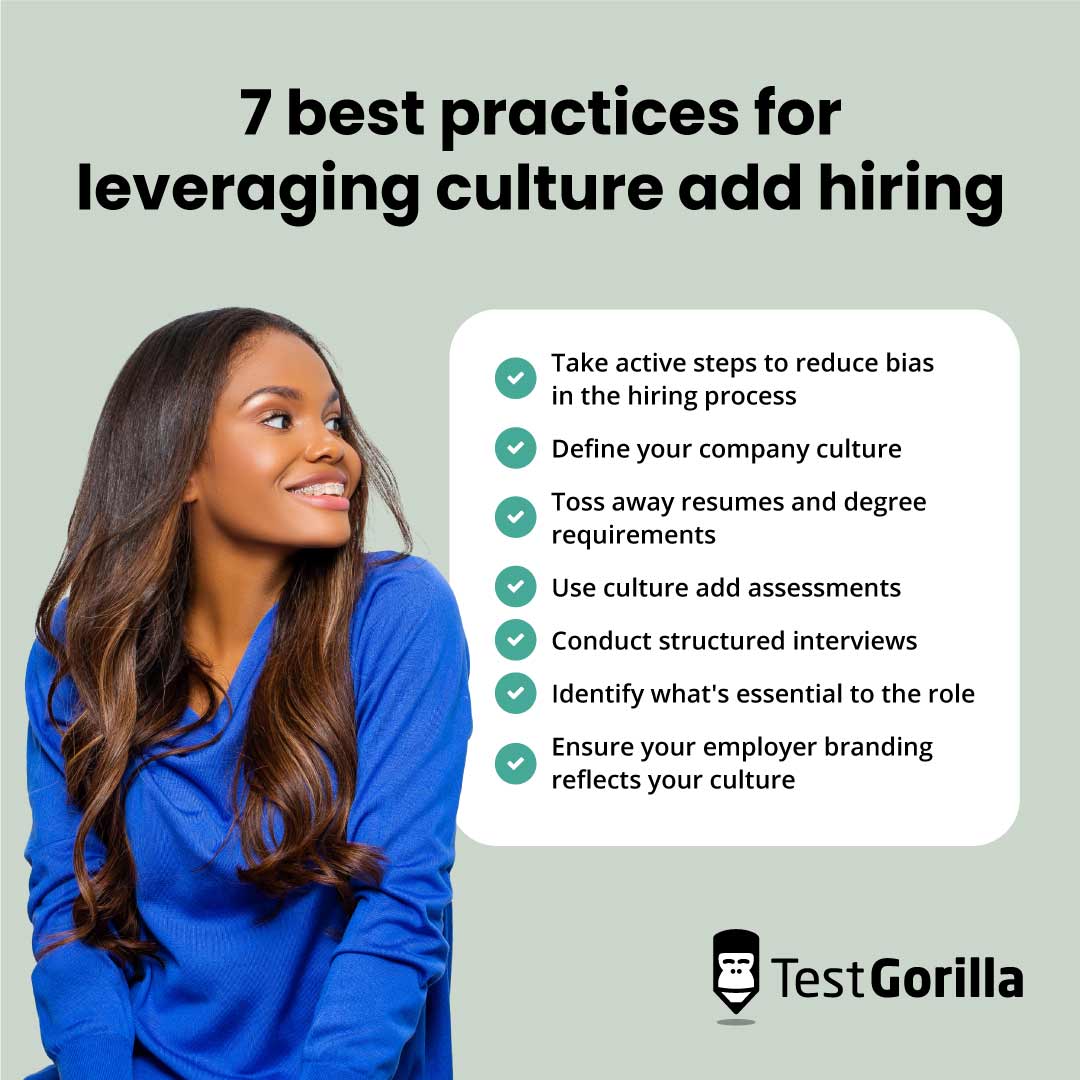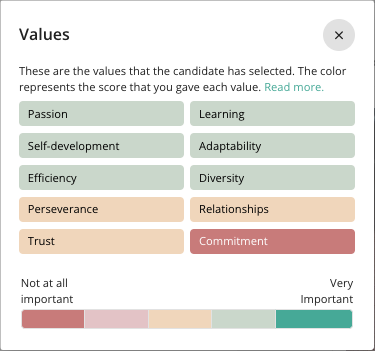Culture add: How to leverage this talent acquisition strategy and build a unique, high-functioning team
Hiring for culture fit is a typical way of assessing new hires, but when you hire people to fit into an organization, you run into some major disadvantages.
This method creates a homogenous workforce, which stifles the innovation that emerges from different backgrounds and new perspectives.
Culture fit also deters thousands of candidates from applying to your company because they know you may overlook them if they don’t fit strict criteria, such as attending the right school.
All of this damages your employer branding and corporate identity.
On the other hand, culture add aligns candidates with your company’s values but encourages unique backgrounds and opinions.
Culture add is the future of recruitment because it helps companies stay competitive, creative, and agile. It also opens your talent pool because your perspective isn’t narrowed by strict requirements.
This blog discusses the importance of culture add as a talent acquisition strategy and how it helps your company build a high-performing team aligned with your organization’s culture.
Table of contents
- What is culture add?
- Why is hiring for culture add important?
- The benefits of hiring for culture add
- 7 best practices for leveraging culture add hiring to acquire top talent
- 3 examples of companies succeeding with culture add hiring as a talent acquisition strategy
- Build a great company by assessing culture add
What is culture add?
Culture add, meaning hiring employees based on their values and encouraging and respecting differences and diverse perspectives, is a way to assess cultural alignment.
In other words, this is the concept of recruiting candidates who suit your workplace but bring new ideas and practices with them.
Let’s look at a couple of culture add examples:
A candidate holds your values of being results-driven and fast-paced, but they differ from your workforce in their relaxed, casual attitude
A candidate shares your values of putting the client first, but they aren’t as lighthearted and humorous as their co-workers
Neither of these candidates harms the core values of your workplace culture – in fact, these scenarios could make a few team members feel more accepted because they also identify with those behaviors.
Hiring for culture add is gaining traction quickly because it fosters inclusivity and innovation in the workplace and attracts today’s candidates. Plus, it can help companies tackle modern talent acquisition trends.
For example, recruiting internationally is much more streamlined when you open your cultural perspectives.
The difference between culture add vs. culture fit
Before we move on, let’s clearly define the difference between culture add and culture fit. Here’s a quick summary:
Culture add | Culture fit |
- Considers the candidate’s alignment with the organization’s values - Welcomes new thoughts, ideas, and backgrounds - Doesn’t bring personal traits and interests into consideration | - Considers the candidate’s alignment with the organization’s values - Considers personal character traits and hobbies - Aligns a candidate by using qualifiers like educational background and experiences - Focuses on maintaining the current culture rather than fostering new ideas |
For our in-depth comparison and the background of culture fit, read our article on culture add vs. culture fit.
Why is hiring for culture add important?
Hiring for culture add has become more important than ever because culture fit doesn’t serve its original purpose well.
Culture fit wasn’t always as damaging as it is right now. Originally, it focused on assessing values, but after a while, bias took hold and warped it into a “Can I have a beer with this person after work?” test.
It’s also become rather hollow. Culture fit makes it simple to say, “We’re all the same here” and “We’re a family” without focusing on real inclusivity and a positive work environment.
This attitude leads to a homogenous workforce and a toxic company culture and perpetuates hiring bias during the recruiting process. For more information on the subject, read our blog on the pitfalls of hiring for culture fit.
Let’s take a look at the top reasons why culture add is important for modern companies:
Helps a company grow and develop: Culture add gives your company the diverse thought that ensures it’s constantly growing and innovating, discouraging groupthink.
Builds an agile, innovative workforce: Hiring people from different backgrounds gives your business new insights and ideas instead of only relying on the perspectives of one type of people.
Keeps companies competitive: Growth and innovation help companies stay ahead. Research shows that ethnically diverse companies outperform less diverse companies by 35% on average.[1]
Matches your employees to your customer base: Diverse employees help align businesses to their customer base, a great tactic for your CSR strategy. For example, disabled consumers may be more likely to support a company that employs disabled people.
Hiring for culture add also holds a lot of importance for your workforce.
Culture add helps employees feel accepted for their authentic selves. For example, if a new culture add is less stuffy and buttoned-up, it helps other relaxed employees feel more accepted.
It also helps new candidates feel like they aren’t being forced into a mold just to get a job. Culture add improves the employee and candidate experience.
Culture add builds a diverse workforce and widens employee perspectives. A new employee brings innovative ideas and helps current staff expand their thinking and grow.
The best insights on HR and recruitment, delivered to your inbox.
Biweekly updates. No spam. Unsubscribe any time.
The benefits of hiring for culture add
Expanding your cultural perspective naturally improves performance, increases diversity, and widens the talent pool.
Let’s look at four proven benefits of hiring for culture add.
Encourages a diverse workforce
Opening your company beyond rigid cultural boundaries naturally increases your organization's diversity.
As we mentioned earlier, culture fit perpetuates a homogenous culture.
This process happens slowly and gradually, and most companies don’t intend it. For example, you begin to associate a good employee with one of your top employees, who happens to be a White male.
You then compare future candidates’ education, experiences growing up, and even family life with his.
You consider one specific background as the ideal candidate.
Culture add, on the other hand, helps diversity thrive. Because it relies on core values only, this method helps you discover talent that aligns with your culture but also has a rich, diverse background.
“Diversity” is a broad umbrella, too.
According to Forbes, diversity doesn’t only include ethnicity and gender but many other things, such as different socioeconomic backgrounds and neurotypes.
Boosts creativity and innovation
Hiring for culture add encourages a wider range of perspectives and opinions that help spur innovation and problem-solving.
It boosts inherent and acquired diversity:
Inherent diversity: Traits you are born with, such as gender, ethnicity, and sexual orientation
Acquired diversity: Traits you gain from experience, such as learning cultural traits from living in another country
When a company has both qualities, it has 2-D diversity.
Employees from companies with 2-D diversity were 45% more likely to report that their firm’s market share grew over the previous year and 70% likelier to report that the firm captured a new market.[2]
Culture add builds the 2-D diversity that gives your team new ways to relate to your customers and create valuable products. For example, you can have specific insights into the needs of working parents if you employ them.
Improves performance
Culture add teams, such as gender-diverse and ethnically diverse teams, outperform less diverse teams.
Companies in the top quartile for gender diversity on leadership teams were 25% more likely to have above-average profitability than companies in the fourth quartile. Moreover, research shows that that number is growing each year.
This study also found that the greater the representation, the higher the likelihood of outperformance.
Companies with more than 30% women executives were more likely to outperform companies where this percentage ranged from 10% to 30%, and in turn, these companies were more likely to outperform companies with even fewer women executives.
These numbers make a great case for a rich, inclusive workspace rather than a few token diverse hires.
This success is due to the diverse perspectives and thoughts. We know it’s a little repetitive, but we can’t overstate the impact diverse opinions and backgrounds have on a company.
Widens the talent pool
When you expand your idea of what aligns with your culture, you simultaneously extend your reach to thousands more candidates.
When hiring, you must find a candidate with the right hard skills, soft skills, and language ability, which already limits you to a handful of candidates.
But narrowing your idea of culture too much shrinks your talent pool even more. Only wanting “candidates who have attended XYZ college” or “candidates who have three to five years of experience in a certain field” is too restrictive.
Culture fit can even narrow your talent pool to the point where you reject a candidate based on their clothing.
For example, a story from Reddit describes how a candidate with the right skills and competencies didn’t get the job because he wore a button-up shirt and khakis instead of a suit to the job interview.
The company believed he wouldn’t fit their professional culture.
Companies with strict dress codes can hire the ideal candidate and instruct them on proper attire once they join the team.
Culture add lets you look beyond small things like a candidate’s outfit or body language and focus on their core values.
7 best practices for leveraging culture add hiring to acquire top talent
Hiring for culture add has distinct advantages, and one of them is being a smart talent acquisition strategy.
Here are our top tactics for securing great candidates with culture add hiring.
Strategies for acquiring top talent with culture add: A summary
Strategies | Description |
1. Take active steps to reduce bias in the hiring process | Remove barriers to diversity in your hiring process, such as committing yourself to inclusive language |
2. Define your company culture | Take the time to determine the core values that are non-negotiable in your company |
3. Toss away resumes and degree requirements | Use alternative methods of candidate screening so you can stop relying on traditional, bias-ridden methods |
4. Use culture add assessments | Take advantage of cultural assessments to objectively gauge cultural and behavioral alignment |
5. Conduct structured interviews | Leverage job interviews with predetermined criteria and ask culture add interview questions |
6. Identify what's essential to the role | Don’t rely on stereotypes, and ensure you determine what’s necessary for your specific role |
7. Ensure your employer branding reflects your culture | Promote your culture transparently to attract candidates who suit your company |
1. Take active steps to reduce bias in the hiring process
Take a step back and assess your hiring process, review it for bottlenecks, and monitor talent acquisition analytics to discover applicant drop-off points.
Then, remove opportunities for bias wherever possible.
Unconscious bias is the number one cause of the drawbacks associated with culture fit. After all, most hiring managers would never try to be exclusionary. They just use their gut instinct to do what they think is best.
A great way to reduce bias is by adopting inclusive hiring, a collection of methods that involve removing possible barriers to inclusivity from the hiring process.
Here are a few inclusive hiring practices to try at your company:
Use inclusive language throughout your company and in job descriptions
Test applicants with talent assessments rather than relying on resumes
Ensure your process is accessible to people with disabilities, such as offering special accommodations
Try a variety of sourcing channels, such as niche job boards or social media recruiting on platforms like LinkedIn, Facebook, and Instagram
Tactics like these enable you to naturally open your hiring process to culture add candidates by removing barriers to entry.
2. Define your company culture
Take a moment to consider your company culture and beliefs.
When you determine which values are critically important and which are just a common theme among your workforce, you understand what a culture add employee looks like.
After you know what’s important to your company, you can focus on the core values rather than gauge candidates on less important factors.
For example, you discover that your organization’s most important values are independence and challenging the status quo. These values help your employees thrive in the company environment, and without them, new hires struggle.
But as long as candidates have these qualities, they can be from any background and still succeed.
Defining your company culture is similar to capability building, determining the main skills and traits your company needs to succeed. Understanding what your specific company requires helps you shape the future.
3. Toss away resumes and degree requirements
Relying on resumes and college degree requirements encourages human bias and gradually leads to a homogenous company.
Getting rid of these traditional hiring methods helps reduce bias and takes away a few unconscious ways to judge for culture fit, like looking for candidates from the same college you went to.
This practice isn’t malicious – many hiring managers only rely on these methods because they have no other way to evaluate candidates.
Our research found that 38% of employers don’t believe resumes are effective, but 44.6% also say they have no other way to rank candidates.
What recruiters and hiring managers need is a better way to qualify candidates. With talent acquisition technology, they have it.
When you commit to skills-based hiring, you can evaluate candidates with talent assessment tests and structured interviews, eliminating the need for resumes and the biases they hold.
For example, instead of looking at a resume for years of experience in a UX role, you can assess candidates with a UX/UI Design test.
Talent assessments even offer a way to gauge culture add. Let’s talk about that next.
4. Use culture add assessments
Talent assessments provide an accurate method for judging cultural add. Judging it is important because we’ve never had objective ways to assess cultural alignment historically.
Our Culture Add test works by establishing certain criteria (i.e., your core values) and evaluating all candidates against them. Then you review the results.
Here’s how to do it:
Complete a questionnaire to establish the standard for your culture
The test evaluates each candidate equally on core values and behaviors
The values ensure new hires align with your organization’s values
The behaviors help round out your current team’s behaviors into a more diverse group
The results of the candidate’s cultural values look like this:
You can then use the scores to determine how aligned the candidate is.
Using the above example, you could choose to go ahead with this person because more than half of their answers align well with your culture.
5. Conduct structured interviews
Structured interviews are an excellent way to gauge culture add. These interviews are scripted and have predetermined criteria to help the interviewer avoid leaning on bias and gut instincts for decision-making.
These interviews work well in combination with talent assessments. For example, you craft structured interview questions that ask candidates for deeper information based on their test results.
You can also include culture add interview questions in your structured interview script. These questions specifically aim to discover cultural add candidates.
Here are a few culture add examples for your structured interview script:
Type of question | Example |
Situational | You must improve a task you thought went well. How would you respond to constructive feedback? |
Leadership | What values do you endorse and contribute to our organization? |
Career growth | Which specific skills do you want to develop if hired? |
Teamwork | Which values help you diffuse tension when working as part of a team whose members disagree with each other? |
These questions enable the candidate to expand on their values and offer a chance for diverse behaviors.
Read our full article on culture add interview questions for more insights on this topic.
6. Identify what's essential to the role
Take the time to identify what’s truly necessary for success in the role.
Companies inadvertently encourage good culture fit by listing certain traits as “required for the role” when they aren’t. For example, some companies want all employees to be extroverts, even if they only need extroversion in customer-facing positions.
Determine non-negotiable skills and behavioral competencies by asking your team, checking performance records, and assessing people in similar roles with talent assessments.
Another useful tactic is considering your team as a whole. Which qualities and skills is your team missing that this new person could bring to the table?
This strategy helps you determine the key skills and traits necessary for success in a role but also expands on your current team and fills certain skills gaps.
7. Ensure your employer branding reflects your culture
Determining the key values your organization needs and hiring for them creates a strong company culture that shows in your employer branding.
You attract candidates who align with your culture and naturally bring in more diverse candidates because you’re advertising your stance on inclusivity – you’re telling candidates that they don’t need to meet a rigid standard.
A few culture add examples of employer branding are:
Promoting your stance on diversity
Ensuring candidates know about your company’s flexibility in the workplace
Making it clear that you offer support for childcare and gender-affirming care
It’s also important to clarify your core values in your recruitment marketing so candidates know what’s most important, but beyond that, they can bring variety to the table.
3 examples of companies succeeding with culture add hiring as a talent acquisition strategy
Here’s a quick look at three companies hiring for culture add and attracting top talent with their strategies.
These organizations recognize that culture is important, but enforcing culture fit stifles company growth and development.
Companies using culture add to hire top talent: A summary
Company | Why it’s successful |
Patagonia | Focuses on compassion as a value instead of strictly looking for environmentalists |
Etsy | Looks for candidates who complement its existing workforce and is mindful of unconscious bias |
Braze | Asks its people for their opinion on core values and hires for them |
Patagonia
It isn’t the first time we’ve mentioned Patagonia, an outdoor clothing company, and its successful inclusive practices. It’s a big name for its compensation and benefits for working parents, but its inclusivity stems from its focus on culture add.
Dean Carter, the head of human resources, says the company tries to avoid a homogenous company culture in its hiring process.
“We’re not looking for culture fit; we’re looking for culture add.” [3]
The team at Patagonia wants people from different walks of life. Hiring managers ensure that every employee doesn’t think and behave similarly.
This organization wants to hire people who are passionate about the environment but also wants to avoid “climate drones” – candidates focused on the environment and nothing else.
So, instead, Patagonia puts a focus on its main core value: compassion towards others. This value helps it find candidates with the right beliefs and values to succeed at Patagonia and opens its doors to unique individuals.
Etsy
Etsy knows how unconscious bias creeps into a hiring decision and perpetuates culture fit.
This company tries hard to build a unique talent pipeline because diversity and inclusion are core values. It shows in its diversity metrics.
More than 50% of Etsy’s employees are women, and 0.5% are non-binary. Further, it made a diversity goal of doubling the number of Black and Hispanic employees from 2019 to 2023 but accomplished this goal in 2020.
This company focuses on how candidates “complement and improve” its atmosphere rather than be the same as the current staff. It is also an active partner of several diversity programs in tech communities, including Jopwell and Lesbians Who Tech.[4]
Braze
Braze, a customer engagement platform, keeps its culture alive and invites new thoughts and ideas.
This business has an excellent strategy for culture add hiring: It asked its employees which core values mattered the most to them and built the culture around their answers.
This approach opens the door to new ideas and diverse talent, recognizes current employees, and tells them they’re valuable.
Here are a few of Braze’s top organizational values:
Grit
Intrinsic motivation
Inclusivity
Individuality
Support for all people
Consider those last three values: inclusivity, individuality, and support for all people. These suit the concept of culture add perfectly, so it’s easy to see why Braze supports it.[5]
Build a great company by assessing culture add
Culture fit has overstayed its welcome, but culture add is a talent acquisition strategy well worth your time.
Revamp your idea of cultural alignment by trying a handful of our suggestions above. Start by defining your culture, identifying what’s essential to your open roles, and using culture assessments to find candidates who help your company flourish.
For more information on how your culture helps you secure top talent, read our piece on building and maintaining a good company culture.
Check out our test library to browse more than 300 talent assessments to use in your inclusive hiring strategy.
Sources
"Why diversity matters". (January 1, 2015). McKinsey and Company. Retrieved October 17, 2023. https://www.mckinsey.com/capabilities/people-and-organizational-performance/our-insights/why-diversity-matters
Hewlett, Sylvia Ann; Marshall, Melinda; Sherbin, Laura. (December 2013). "How Diversity Can Drive Innovation." Harvard Business Review. Retrieved October 17, 2023. https://hbr.org/2013/12/how-diversity-can-drive-innovation
Anderson, Bruce M. (September 27, 2019). "5 ‘Ridiculous’ Ways Patagonia Has Built a Culture That Does Well and Does Good". LinkedIn Talent Blog. Retrieved October 17, 2023. https://www.linkedin.com/business/talent/blog/talent-connect/ways-patagonia-built-ridiculous-culture
Wink, Christopher. (April 5, 2017). "Etsy doesn’t want ‘cultural fit’". Technical.ly. Retrieved October 17, 2023. https://technical.ly/uncategorized/etsy-doesnt-want-cultural-fit/
Valentine, Kimberly. (June 29, 2022). "Goodbye Culture Fit, Hello Value Fit: What 5 Companies Look for in a Hire". Built In Chicago. Retrieved October 17, 2023.https://www.builtinchicago.org/2022/06/28/5-companies-look-hire
You've scrolled this far
Why not try TestGorilla for free, and see what happens when you put skills first.


